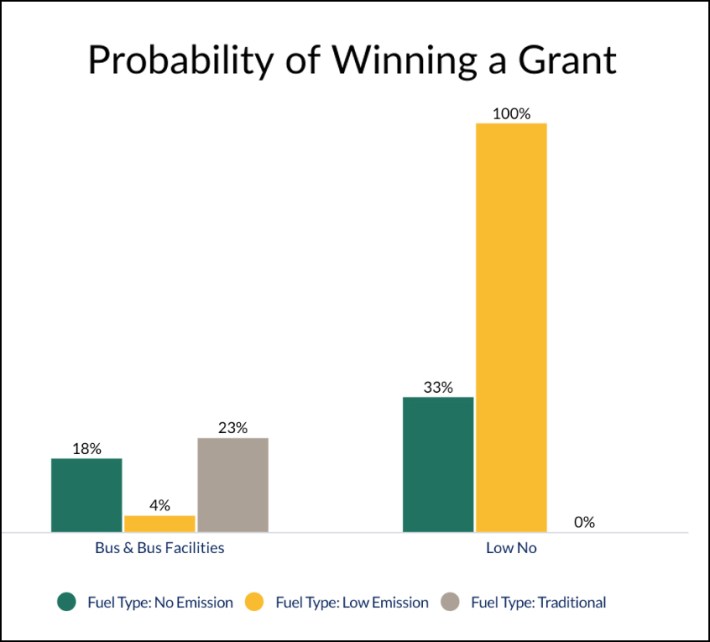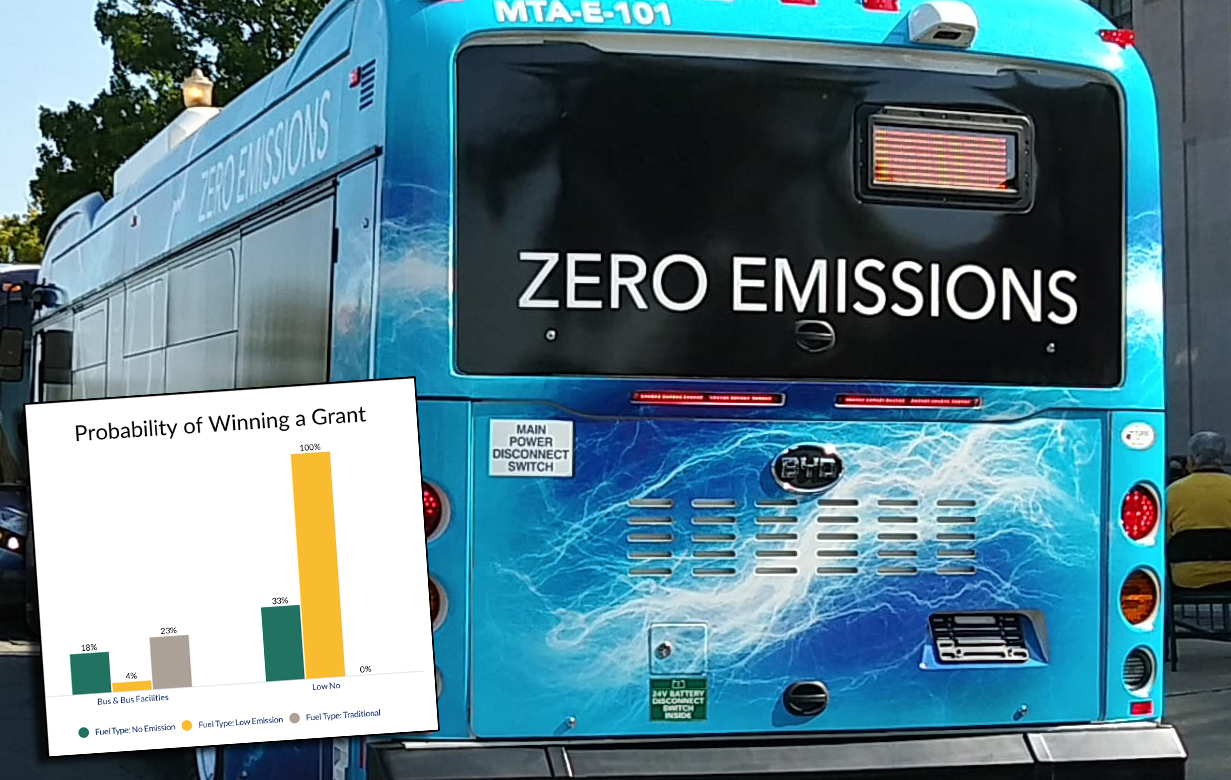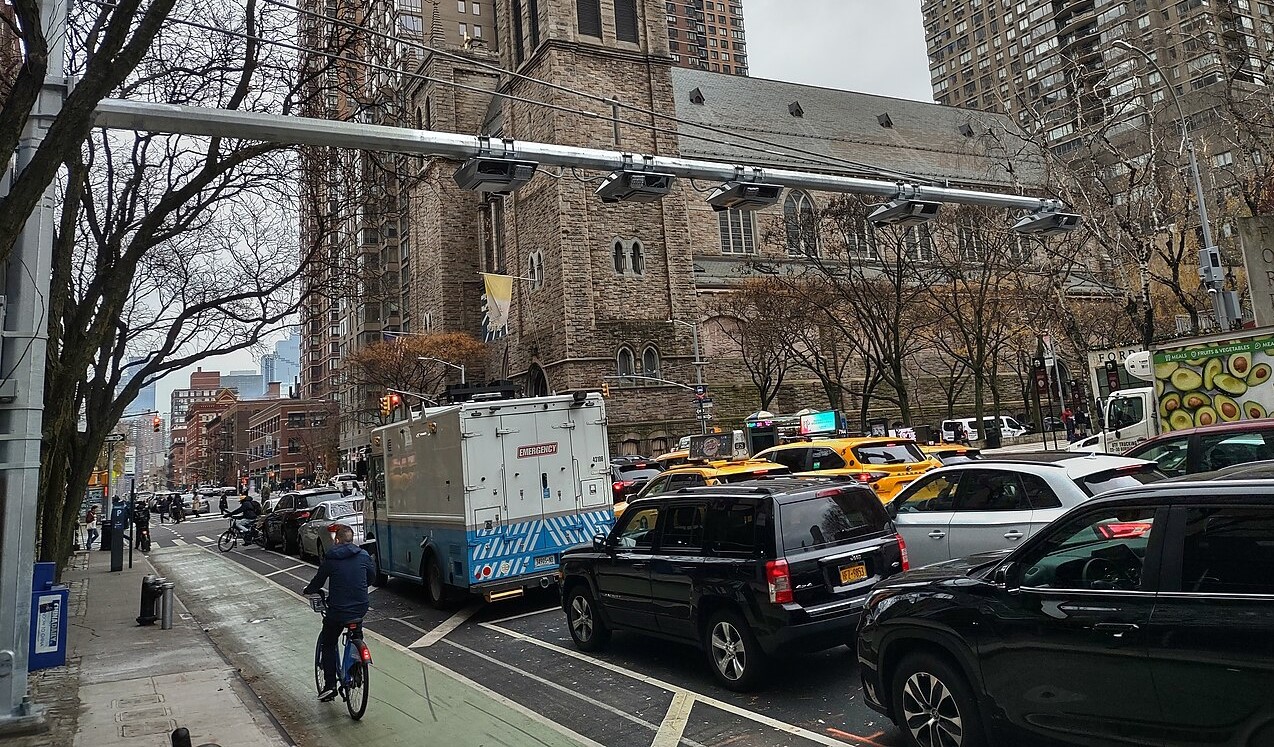A federal grant program aimed at speeding America’s transition to zero-emissions transit is being undermined by a requirement that one-quarter of the spending be allocated to low-polluting vehicles — leading to shortages in grants to agencies seeking to bolster their no-pollution fleet.
After passage of the 2021 infrastructure bill, the Federal Transit Administration awarded grants to support clean or cleaner bus fleets and facilities in rural, suburban, and hyper-dense areas across the country. By law, 25 percent of the five-year $5.5-billion Low or No Emission Vehicle (a.k.a. “Low No”) program must go to low-emission vehicles such as diesel hybrids or buses powered by compressed natural gas — and every agency that sought grant money for the polluting vehicles obtained it, while only 33 percent of agencies that sought zero-emission grants earned them.
That’s because the zero-emission grants were far more competitive, while fewer agencies sought low-emission grants, says the advocacy group Transportation for America in a new report analyzing FY22 Low No applications.
“Even though 88 percent of applications were for no-emission buses and facilities, FTA was required to award 25 percent of the funding to more polluting low-emission projects,” the report stated. “Due to this requirement, nearly 100 percent of the low-emission projects received an award, while more than two-thirds of clean zero-emission applications were rejected. There weren’t even enough low-emission projects in the application pool to meet the 25 percent requirement.”
Now, T4A is calling on Congress to revise a policy that the group argues is stuck in the past.
“A lot of transit agencies were ready and responded [for] investing in zero-emission buses for their fleets — perhaps more than maybe any of us expected,” said T4A Outreach Director Chris Rall, who leads the group’s work with the Coalition Helping America Rebuild and Go Electric (aka CHARGE). “That's why this 25-percent requirement […] having to go to low emission is really becoming a problem.”
Rall added that transit agencies are trending away from CNG and that the required fossil fuel funding will likely go toward diesel hybrid vehicles which are more efficient than traditional buses, but still pollute. Because of the 25-percent rule, transit agencies willing to tolerate a little pollution would do well to apply for the “low” funding because all of those grants were awarded.
Low No, as written, creates an incentive structure that “artificially constrain[s] the conversion to zero-emission vehicles,” concluded the report, which Rall co-authored with Grant DuVall. A similar low- and no-emission program, the $2-billion Bus and Bus Facilities Program, which does not have the 25-percent rule, doled out money in a more balanced way (see chart).

It’s not just a matter of pushing more polluting vehicles onto the road, but the 25-percent rule will keep electric bus technology from reaching an economy of scale, Rall added. By that thinking, the less demand there is for electric buses, the longer it will take to move production from the boutique to the assembly line. The 25-percent rule is a relic in federal law that dates back to 2015, when then-Pennsylvania Sen. Pat Toomey sought to encourage slightly cleaner compressed natural gas vehicles — a boon to his state’s CNG extraction industry, which at the time was second only to Texas.
As a result, in an age of climate change awareness, the feds will still subsidize fossil fuel-burning buses to the tune of $1.4 billion over this five-year authorization period.
“One of the worries is that [Low No will] hold back manufacturing,” Rall said. “We're getting towards a critical mass where the transit agencies that are ready to buy electric buses and are figuring out the charging infrastructure issues. And we need the manufacturing sector to kind of ramp up.”
As such, Rall wants to see Congress revise Low No so that transit agencies aren’t stifled by the need to negotiate service and climate goals. He concedes, though, that the most feasible pathway to revising Low No remains a few years out. Rall said Congress typically delivers an “authorization bill” governing transit policy every five to seven years.
When most of the current infrastructure bill’s funding provisions — including Low No — run out in 2026, it will be time to renegotiate how or if the federal government plans to subsidize the transition to electric. Until then, Rall says activists need to stay vigilant and keep congressional leaders apprised of fixable policy shortfalls like Low No going into the next authorization bill.






